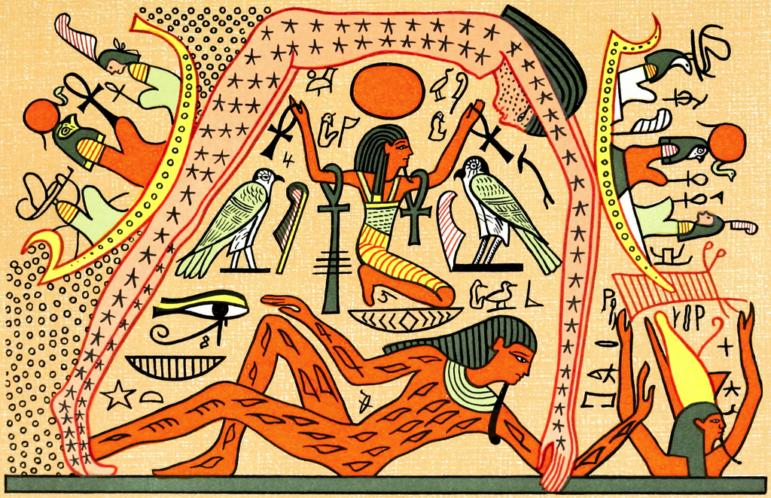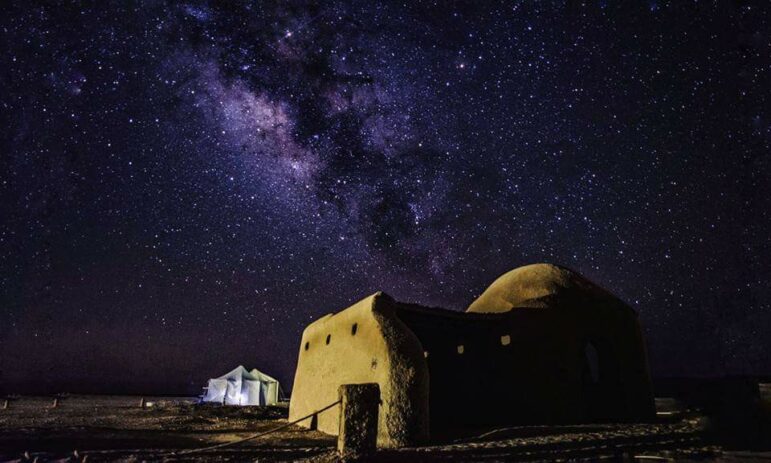
PORTSMOUTH, U.K. – A new paper in the Journal of Astronomical History and Heritage uses astronomical simulations, combined with textual and cross-cultural analysis from ancient Egypt and other cultures, to argue that ancient Egyptians would have understood the Milky Way to have represented parts of the sky goddess Nut.
The role of the Milky Way in ancient Egyptian mythology and cosmology, the paper argues, is not immediately clear. There have been several terms identified as possible names for the Milky Way in ancient Egyptian, but none are definitive and their interpretations may be influenced by resemblances to later languages that could be coincidental, and could as easily refer to other celestial patterns – like the ecliptic – as the Milky Way itself.

Nut, who body arches as the sky, supported by her father Shu; below is her brother and consort, the earth god Geb. From E.A. Wallis-Budge, The Gods of the Egyptians vol. II, 1904 [public domain]
“I chanced upon the sky-goddess Nut when I was writing a book on galaxies and looking into the mythology of the Milky Way,” Or Graur, an associate professor of astrophysics at the University of Portsmouth and author of the paper, said, according to Science Daily. “I took my daughters to a museum and they were enchanted by this image of an arched woman and kept asking to hear stories about her.
“This sparked my interest and I decided to combine both astronomy and Egyptology to do a double analysis — astronomical and cross-cultural — of the sky-goddess Nut, and whether she really could be linked to the Milky Way.”
Graur draws upon ancient Egyptian texts and simulations of the ancient night sky to posit that the Milky Way could have been thought of as the goddess Nut – or least as parts of her. As Graur notes in the study, it should not be thought that there can be simply an equation of Nut to the Milky Way, in the sense that the Greek mythological constellation of, say, Heracles can be identified as the body of the god. This is because Nut is the sky itself, and she is always there – day or night, winter or summer.
Based on primary documents the describe Nut, mainly the Fundamentals of the Course of Stars, previously known as the Book of Nut, Graur draws the following properties of the goddess as she might be observed in the sky:
- Nut represents the entire sky at any given moment, during both day and night. Whilevisual representations of Nut as the day sky and the night sky exist (e.g., in the Book of the Day and the Book of the Night), they are still representations of the same goddess, not two separate entities.
- Nut swallows the Sun as it sets and gives birth to it as it rises. This happens every day, so Nut must always be oriented the same way in the sky, with her head to the west and her rear to the east.
- Throughout the night, Nut also gives birth to the decanal stars as they rise in the east and swallows them again as they set in the west.
These properties make it impossible for Nut’s head and womb to be located on the Milky Way itself. “Instead,” Graur writes, “the Milky Way could be thought of as a physical manifestation of Nut’s torso or backbone during the summer months and of her arms during the winter months.” Graur bases these identifications on descriptions in the Fundamentals, in which a set of decanal stars is described along Nut’s torso during the summer season and Nut’s arms are depicted as extending toward the ascendant god-king. Using computer simulations of the night sky in July and January 1880 B.C.E., Graur demonstrates that the Milky Way’s orientation shifted throughout the year in a way that could be consistent with the backbone/extended arms imagery described in the Fundamentals.

Photo of the Milky Way over Wadi al-Hitan, Faiyum, Egypt [Alaa Adel Awaad, Wikimedia Commons, CC 4.0]
The other half of Graur’s study relies on cross-cultural analysis of depictions of the Milky Way. He notes that other cultures have conceived of the Milky Way as giving birth to stars and divine beings and as having roles in passage to the afterlife similar to Nut’s. He also focuses on some other mythological correspondences that might link Nut to the Milky Way, such as the autumn bird migration, which Graur posits would have followed the path of the changing orientation of the Milky Way.
While any identification of how the ancient Egyptians thought of the Milky Way is likely to remain tentative, Graur’s study – especially the combination of simulated ancient skies and the descriptions in the Fundamentals – is an intriguing notion, and should invite further comparison between descriptions in these ancient astronomical texts and our modern tools to imagine the night sky. We may not be able to know what exactly the ancient devotees of Nut thought when they looked at the Milky Way, but we are better equipped than ever to imagine it for ourselves.
The Wild Hunt is not responsible for links to external content.
To join a conversation on this post:
Visit our The Wild Hunt subreddit! Point your favorite browser to https://www.reddit.com/r/The_Wild_Hunt_News/, then click “JOIN”. Make sure to click the bell, too, to be notified of new articles posted to our subreddit.
